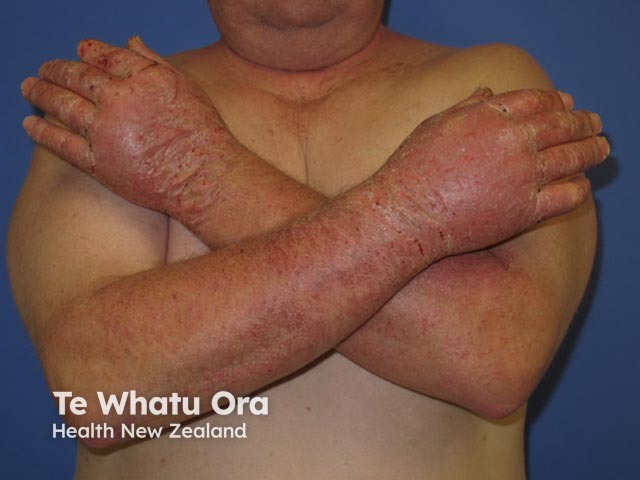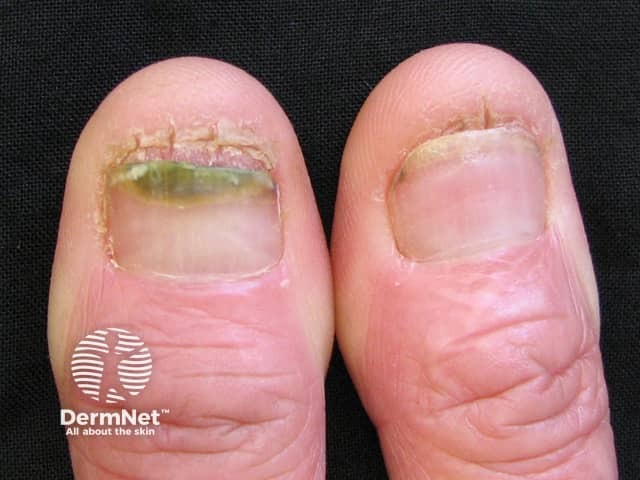Main menu
Common skin conditions

NEWS
Join DermNet PRO
Read more
Quick links
Author: Brian Wu PhD. MD Candidate, Keck School of Medicine; Chief Editor: Dr Amanda Oakley, Dermatologist, Hamilton, New Zealand, December 2015.
" data-index="1" alt="Go to Introduction
" onclick="event.preventDefault();document.getElementsByTagName('h2')[(1 - 1)].scrollIntoView({behavior: 'smooth',block: 'start'});">Introduction
" data-index="2" alt="Go to Occupational risks
" onclick="event.preventDefault();document.getElementsByTagName('h2')[(2 - 1)].scrollIntoView({behavior: 'smooth',block: 'start'});">Occupational risks
" data-index="3" alt="Go to Causes
" onclick="event.preventDefault();document.getElementsByTagName('h2')[(3 - 1)].scrollIntoView({behavior: 'smooth',block: 'start'});">Causes
" data-index="4" alt="Go to Associated skin conditions
" onclick="event.preventDefault();document.getElementsByTagName('h2')[(4 - 1)].scrollIntoView({behavior: 'smooth',block: 'start'});">Associated skin conditions
" data-index="5" alt="Go to Workplace risk assessment
" onclick="event.preventDefault();document.getElementsByTagName('h2')[(5 - 1)].scrollIntoView({behavior: 'smooth',block: 'start'});">Workplace risk assessment
" data-index="6" alt="Go to Personal protective equipment
" onclick="event.preventDefault();document.getElementsByTagName('h2')[(6 - 1)].scrollIntoView({behavior: 'smooth',block: 'start'});">Personal protective equipment
" data-index="7" alt="Go to Hand and skin care
" onclick="event.preventDefault();document.getElementsByTagName('h2')[(7 - 1)].scrollIntoView({behavior: 'smooth',block: 'start'});">Hand and skin care
Treatment
Professional cleaning is a major source of employment and takes place in a wide variety of settings, including schools, hospitals and public and private buildings.
Dermatitis among professional cleaners is common, with potential to have a large impact on employment, economics and patient quality of life. In one study of workers, it was found that cleaners had a significantly higher rates of dermatitis and other skin conditions compared to other building workers.
Professional cleaners are at risk of skin conditions for the following reasons:
A study of rates of dermatitis in the United Kingdom were around 28% for cleaners, versus 18% for the general population.
The epidermal barrier is important for protection against harmful agents such as bacteria, viruses, solar radiation and chemical toxins.
Repeated exposure to chemicals, work with a high risk for mechanical injuries like cuts or abrasions, and wet work can compromise this protective barrier and cause irritation, sensitivity and contact dermatitis. Those with a history of eczema are at greater risk than those without this history.
Professional cleaners are vulnerable to the following conditions.
Contact dermatitis is common in professional cleaners.
Professional cleaners are also at risk for cutaneous yeast infection.
Occupational bacterial infections in cleaners are generally caused by staphylococci or streptococci. They are associated with compromised skin integrity and work in an unclean environment.
Infections in cleaners include:
Contact urticaria is less common than contact dermatitis.

Occupational extensive dermatitis

Candida nail infection

Infected hand
If skin conditions are a problem, the workplace should be assessed. Improvements could possibly include the following:
Use of personal protective equipment has been shown to help reduce worker exposure to irritants and sensitising agents. However, this is dependent on employees knowing which type of glove to choose for which job, how to don, remove and dispose of them safely and how many hours they should be worn. Also, there is also a chance of the gloves themselves causing contact dermatitis if a person become sensitised to their materials (such as latex or rubber accelerators), or sweats heavily under them.
For cleaners who are wanting to keep their skin healthy, the following guidelines are recommended:
Because skin conditions in professional cleaners are common, doctors should be aware of health risks associated with this occupation — keep in mind that skin conditions can sometimes go under-reported and underdiagnosed.
Treatment will naturally depend on the particular skin condition, but may include: